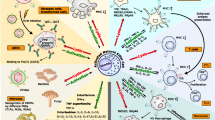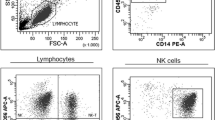Abstract
Cancer patients with advanced disease display signs of immune suppression, which constitute a major obstacle for effective immunotherapy. Both T cells and NK cells are affected by a multitude of mechanisms of which the generation of reactive oxygen species is of major importance. Therefore, we hypothesized that two weeks of high-dose treatment with the anti-oxidant vitamin E may enhance NK cell function in cancer patients by protecting from oxidative stress. Seven patients with colorectal cancer (Dukes stage C and D) received a daily dose of 750 mg of vitamin E during a period of two weeks and the function, phenotype and receptor expression of NK cells were analyzed. The short-term vitamin E treatment significantly improved NK cell cytolytic activity in six out of the seven patients analyzed. The increased NK cell activity in patients’ PBMC was not due to increased numbers of NK cells or an increase in the proportion of the CD56dim NK cell subpopulation. Furthermore, neither an increased perforin expression nor an enhanced ability of NK cells to produce IFN-γ was observed as a result of vitamin E treatment. Finally, vitamin E treatment was associated with a minor, but consistent, induction of NKG2D expression in all patients analyzed. In conclusion, this pilot study demonstrates that vitamin E may boost NK cell function in patients with colorectal cancer. Further studies are warranted to explore the potential of vitamin E as an adjuvant for immunotherapy against cancer and to determine the underlying mechanism(s) behind vitamin E induced NK cell activation.






Similar content being viewed by others
References
Alter G, Malenfant JM, Altfeld M (2004) CD107a as a functional marker for the identification of natural killer cell activity. J Immunol Methods 294:15–22
Aoe T, Okamoto Y, Saito T (1995) Activated macrophages induce structural abnormalities of the T cell receptor-CD3 complex. J Exp Med 181:1881–1886
Asemissen AM, Scheibenbogen C, Letsch A, Hellstrand K, Thoren F, Gehlsen K, Schmittel A, Thiel E, Keilholz U (2005) Addition of histamine to interleukin 2 treatment augments type 1 T-cell responses in patients with melanoma in vivo: immunologic results from a randomized clinical trial of interleukin 2 with or without histamine (MP 104). Clin Cancer Res 11:290–297
Ashfaq MK, Zuberi HS, Anwar Waqar M (2000) Vitamin E and beta-carotene affect natural killer cell function. Int J Food Sci Nutr 51(Suppl):S13–S20
Baeuerle PA, Henkel T (1994) Function and activation of NF-kappa B in the immune system. Annu Rev Immunol 12:141–179
Beharka A, Redican S, Leka L, Meydani SN (1997) Vitamin E status and immune function. Methods Enzymol 282:247–263
Betts MR, Brenchley JM, Price DA, De Rosa SC, Douek DC, Roederer M, Koup RA (2003) Sensitive and viable identification of antigen-specific CD8+ T cells by a flow cytometric assay for degranulation. J Immunol Methods 281:65–78
Bryceson YT, March ME, Ljunggren HG, Long EO (2006) Synergy among receptors on resting NK cells for the activation of natural cytotoxicity and cytokine secretion. Blood 107:159–166
Chandra RK (1992) Effect of vitamin and trace-element supplementation on immune responses and infection in elderly subjects. Lancet 340:1124–1127
Chung HY, Sung B, Jung KJ, Zou Y, Yu BP (2006) The molecular inflammatory process in aging. Antioxid Redox Signal 8:572–581
Cooper MA, Fehniger TA, Caligiuri MA (2001) The biology of human natural killer-cell subsets. Trends Immunol 22:633–640
Cooper MA, Fehniger TA, Turner SC, Chen KS, Ghaheri BA, Ghayur T, Carson WE, Caligiuri MA (2001) Human natural killer cells: a unique innate immunoregulatory role for the CD56(bright) subset. Blood 97:3146–3151
Ericsson C, Seregard S, Bartolazzi A, Levitskaya E, Ferrone S, Kiessling R, Larsson O (2001) Association of HLA class I and class II antigen expression and mortality in uveal melanoma. Invest Ophthalmol Vis Sci 42:2153–2156
Fabiani R, De Bartolomeo A, Rosignoli P, Morozzi G (2001) Antioxidants prevent the lymphocyte DNA damage induced by PMA-stimulated monocytes. Nutr Cancer 39:284–291
Ferrandez MD, Correa R, Del Rio M, De la Fuente M (1999) Effects in vitro of several antioxidants on the natural killer function of aging mice. Exp Gerontol 34:675–685
Fontenot JD, Rudensky AY (2005) A well adapted regulatory contrivance: regulatory T cell development and the forkhead family transcription factor Foxp3. Nat Immunol 6:331–337
Gabrilovich D (2004) Mechanisms and functional significance of tumour-induced dendritic-cell defects. Nat Rev Immunol 4:941–952
Gackowski D, Banaszkiewicz Z, Rozalski R, Jawien A, Olinski R (2002) Persistent oxidative stress in colorectal carcinoma patients. Int J Cancer 101:395–397
Ghiringhelli F, Menard C, Terme M, Flament C, Taieb J, Chaput N, Puig PE, Novault S, Escudier B, Vivier E, Lecesne A, Robert C, Blay JY, Bernard J, Caillat-Zucman S, Freitas A, Tursz T, Wagner-Ballon O, Capron C, Vainchencker W, Martin F, Zitvogel L (2005) CD4+CD25+ regulatory T cells inhibit natural killer cell functions in a transforming growth factor-beta-dependent manner. J Exp Med 202:1075–1085
Hahne M, Rimoldi D, Schroter M, Romero P, Schreier M, French LE, Schneider P, Bornand T, Fontana A, Lienard D, Cerottini J, Tschopp J (1996) Melanoma cell expression of Fas(Apo-1/CD95) ligand: implications for tumor immune escape. Science 274:1363–1366
Halpner AD, Handelman GJ, Harris JM, Belmont CA, Blumberg JB (1998) Protection by vitamin C of loss of vitamin E in cultured rat hepatocytes. Arch Biochem Biophys 359:305–309
Hansson M, Asea A, Ersson U, Hermodsson S, Hellstrand K (1996) Induction of apoptosis in NK cells by monocyte-derived reactive oxygen metabolites. J Immunol 156:42–47
Hellstrand K, Asea A, Dahlgren C, Hermodsson S (1994) Histaminergic regulation of NK cells. Role of monocyte-derived reactive oxygen metabolites. J Immunol 153:4940–4947
Horiguchi S, Petersson M, Nakazawa T, Kanda M, Zea AH, Ochoa AC, Kiessling R (1999) Primary chemically induced tumors induce profound immunosuppression concomitant with apoptosis and alterations in signal transduction in T cells and NK cells. Cancer Res 59:2950–2956
Jondal M, Pross H (1975) Surface markers on human b and t lymphocytes. VI. Cytotoxicity against cell lines as a functional marker for lymphocyte subpopulations. Int J Cancer 15:596–605
Kabe Y, Ando K, Hirao S, Yoshida M, Handa H (2005) Redox regulation of NF-kappaB activation: distinct redox regulation between the cytoplasm and the nucleus. Antioxid Redox Signal 7:395–403
Khong HT, Restifo NP (2002) Natural selection of tumor variants in the generation of “tumor escape” phenotypes. Nat Immunol 3:999–1005
Kiessling R, Wasserman K, Horiguchi S, Kono K, Sjoberg J, Pisa P, Petersson M (1999) Tumor-induced immune dysfunction. Cancer Immunol Immunother 48:353–362
Kono K, Salazar-Onfray F, Petersson M, Hansson J, Masucci G, Wasserman K, Nakazawa T, Anderson P, Kiessling R (1996) Hydrogen peroxide secreted by tumor-derived macrophages down-modulates signal-transducing zeta molecules and inhibits tumor-specific T cell-and natural killer cell-mediated cytotoxicity. Eur J Immunol 26:1308–1313
Ladisch S, Becker H, Ulsh L (1992) Immunosuppression by human gangliosides: I. Relationship of carbohydrate structure to the inhibition of T cell responses. Biochim Biophys Acta 1125:180–188
Lanier LL, Le AM, Civin CI, Loken MR, Phillips JH (1986) The relationship of CD16 (Leu-11) and Leu-19 (NKH-1) antigen expression on human peripheral blood NK cells and cytotoxic T lymphocytes. J Immunol 136:4480–4486
Lanier LL (2005) NK cell recognition. Annu Rev Immunol 23:225–274
Li X, Hill KE, Burk RF, May JM (2001) Selenium spares ascorbate and alpha-tocopherol in cultured liver cell lines under oxidant stress. FEBS Lett 508:489–492
Lindner P, Rizell M, Mattsson J, Hellstrand K, Naredi P (2004) Combined treatment with histamine dihydrochloride, interleukin-2 and interferon-alpha in patients with metastatic melanoma. Anticancer Res 24:1837–1842
Malmberg KJ, Arulampalam V, Ichihara F, Petersson M, Seki K, Andersson T, Lenkei R, Masucci G, Pettersson S, Kiessling R (2001) Inhibition of activated/memory (CD45RO(+)) T cells by oxidative stress associated with block of NF-kappaB activation. J Immunol 167:2595–2601
Malmberg KJ, Lenkei R, Petersson M, Ohlum T, Ichihara F, Glimelius B, Frodin JE, Masucci G, Kiessling R (2002) A short-term dietary supplementation of high doses of vitamin E increases T helper 1 cytokine production in patients with advanced colorectal cancer. Clin Cancer Res 8:1772–1778
Malmberg KJ, Ljunggren HG (2006) Escape from immune- and nonimmune-mediated tumor surveillance. Semin Cancer Biol 16:16–31
May JM, Qu ZC, Mendiratta S (1998) Protection and recycling of alpha-tocopherol in human erythrocytes by intracellular ascorbic acid. Arch Biochem Biophys 349:281–289
Moretta A, Bottino C, Vitale M, Pende D, Cantoni C, Mingari MC, Biassoni R, Moretta L (2001) Activating receptors and coreceptors involved in human natural killer cell-mediated cytolysis. Annu Rev Immunol 19:197–223
Moretta A, Bottino C, Mingari MC, Biassoni R, Moretta L (2002) What is a natural killer cell? Nat Immunol 3:6–8
Niki E, Noguchi N (2004) Dynamics of antioxidant action of vitamin E. Acc Chem Res 37:45–51
O’Connell J, O’Sullivan GC, Collins JK, Shanahan F (1996) The Fas counterattack: Fas-mediated T cell killing by colon cancer cells expressing Fas ligand. J Exp Med 184:1075–1082
Rabinowich H, Reichert TE, Kashii Y, Gastman BR, Bell MC, Whiteside TL (1998) Lymphocyte apoptosis induced by Fas ligand- expressing ovarian carcinoma cells. Implications for altered expression of T cell receptor in tumor-associated lymphocytes. J Clin Invest 101:2579–88
Rosenberg SA, Yang JC, Restifo NP (2004) Cancer immunotherapy: moving beyond current vaccines. Nat Med 10:909–915
Schmidt KN, Amstad P, Cerutti P, Baeuerle PA (1996) Identification of hydrogen peroxide as the relevant messenger in the activation pathway of transcription factor NF-kappaB. Adv Exp Med Biol 387:63–68
Schreck R, Rieber P, Baeuerle PA (1991) Reactive oxygen intermediates as apparently widely used messengers in the activation of the NF-kappa B transcription factor and HIV-1. Embo J 10:2247–2258
Seaman WE, Gindhart TD, Blackman MA, Dalal B, Talal N, Werb Z (1982) Suppression of natural killing in vitro by monocytes and polymorphonuclear leukocytes: requirement for reactive metabolites of oxygen. J Clin Invest 69:876–888
Seliger B, Cabrera T, Garrido F, Ferrone S (2002) HLA class I antigen abnormalities and immune escape by malignant cells. Semin Cancer Biol 12:3–13
Serafini M (2000) Dietary vitamin E and T cell-mediated function in the elderly: effectiveness and mechanism of action. Int J Dev Neurosci 18:401–410
Serafini P, De Santo C, Marigo I, Cingarlini S, Dolcetti L, Gallina G, Zanovello P, Bronte V (2004) Derangement of immune responses by myeloid suppressor cells. Cancer Immunol Immunother 53:64–72
Skrzydlewska E, Sulkowski S, Koda M, Zalewski B, Kanczuga-Koda L, Sulkowska M (2005) Lipid peroxidation and antioxidant status in colorectal cancer. World J Gastroenterol 11:403–406
Takahashi A, Hanson MG, Norell HR, Havelka AM, Kono K, Malmberg KJ, Kiessling RV (2005) Preferential cell death of CD8+ effector memory (CCR7-CD45RA-) T cells by hydrogen peroxide-induced oxidative stress. J Immunol 174:6080–6087
Taniguchi K, Petersson M, Hoglund P, Kiessling R, Klein G, Karre K (1987) Interferon gamma induces lung colonization by intravenously inoculated B16 melanoma cells in parallel with enhanced expression of class I major histocompatibility complex antigens. Proc Natl Acad Sci USA 84:3405–3409
Trapani JA, Smyth MJ (2002) Functional significance of the perforin/granzyme cell death pathway. Nat Rev Immunol 2:735–747
Zea AH, Rodriguez PC, Atkins MB, Hernandez C, Signoretti S, Zabaleta J, McDermott D, Quiceno D, Youmans A, O’Neill A, Mier J, Ochoa AC (2005) Arginase-producing myeloid suppressor cells in renal cell carcinoma patients: a mechanism of tumor evasion. Cancer Res 65:3044–3048
Acknowledgments
This work was supported by grants to R.K. from the Swedish Cancer Society, the Cancer Society of Stockholm, the European Union, the Karolinska Institutet, “ALF-project”-grant from the Stockholm City Council and National Institutes of Health (Grant CA102280). K-J.M. was supported by grants from the Cancer Society of Stockholm, the Swedish Society for Medical Research and the Swedish Children’s Cancer Foundation. G.M. was supported by grants from NORDFORSK-NCEV network (Grant 040226), the Cancer Society of Stockholm, and the King Gustaf V Jubilee Fund.
Author information
Authors and Affiliations
Corresponding author
Rights and permissions
About this article
Cite this article
Hanson, M.G.V., Özenci, V., Carlsten, M.C.V. et al. A short-term dietary supplementation with high doses of vitamin E increases NK cell cytolytic activity in advanced colorectal cancer patients. Cancer Immunol Immunother 56, 973–984 (2007). https://doi.org/10.1007/s00262-006-0261-4
Received:
Accepted:
Published:
Issue Date:
DOI: https://doi.org/10.1007/s00262-006-0261-4




